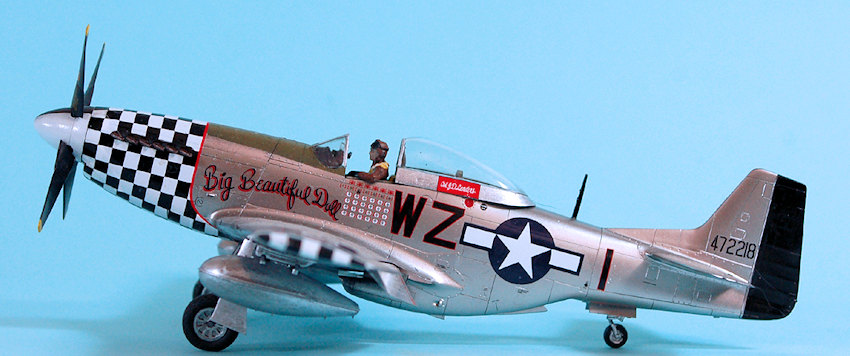
| KIT #: | 61089 |
| PRICE: | $25.00 when new |
| DECALS: | Five options |
| REVIEWER: | Tom Cleaver |
| NOTES: | 8th AF Aces boxing |

| HISTORY |
The P-51D needs no introduction. The airplane provided the Eighth Air Force with the ability to fly a fighter to any target the bombers could reach, that could outfight the defenders once it got there. The introduction of the P-51 in the European Theater changed the nature of the air war in a matter of months.
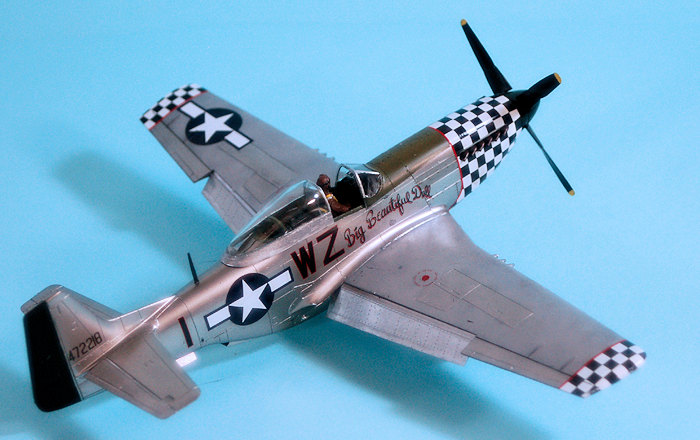 Among the
aces who flew the Mustang, John D. Landers was a standout. A “graduate” of the
USAAF’s first “Advanced Combat Flying School,” otherwise known as the 49th
Pursuit Group, he learned air combat in 1942 flying the P-40E in the 9th Pursuit
Squadron against the best the Imperial Japanese Navy had to offer in the dark
days immediately after Pearl Harbor, and managed to become an ace despite being
shot down and surviving ten days in the trackless jungles of New Guinea, and
later was one of the first “forty-niners” to fly the P-38 when the 9th FS
re-equipped.. As with many other survivors of the 49th, Landers came home in
1943 and provided the leadership in new fighter groups. He transitioned from the P-40 to the P-38 and went to
Europe with the 55th Fighter Group that fall. After a tour in P-38s during whicyh he became a squadron commander he went to the 357th Fighter Group in
October 1944 as Group Commander, where he first flew the P-51. He became the
sixth and final wartime commander of the 78th Fighter Group in February 1945,
leading the group to the end of the war. He is the only American ace to have
scored in the P-40, P-38, and P-51.
Among the
aces who flew the Mustang, John D. Landers was a standout. A “graduate” of the
USAAF’s first “Advanced Combat Flying School,” otherwise known as the 49th
Pursuit Group, he learned air combat in 1942 flying the P-40E in the 9th Pursuit
Squadron against the best the Imperial Japanese Navy had to offer in the dark
days immediately after Pearl Harbor, and managed to become an ace despite being
shot down and surviving ten days in the trackless jungles of New Guinea, and
later was one of the first “forty-niners” to fly the P-38 when the 9th FS
re-equipped.. As with many other survivors of the 49th, Landers came home in
1943 and provided the leadership in new fighter groups. He transitioned from the P-40 to the P-38 and went to
Europe with the 55th Fighter Group that fall. After a tour in P-38s during whicyh he became a squadron commander he went to the 357th Fighter Group in
October 1944 as Group Commander, where he first flew the P-51. He became the
sixth and final wartime commander of the 78th Fighter Group in February 1945,
leading the group to the end of the war. He is the only American ace to have
scored in the P-40, P-38, and P-51.
| THE KIT |
It’s amazing to realize that the Tamiya P-51D is now 22 years old. The Mustang was finally well-served with the release of the Hasegawa kit in 1992, but when the Tamiya kit came out two years later, it became the “definitive” P-51D kit in 1/48.
I picked up this limited-edition release at a recent estate sale held at the LHS. I had managed to miss the initial release since at the time I didn’t want to use the Tamiya decals. After taking a look at the decals at the shop, I bought the kit.
| CONSTRUCTION |
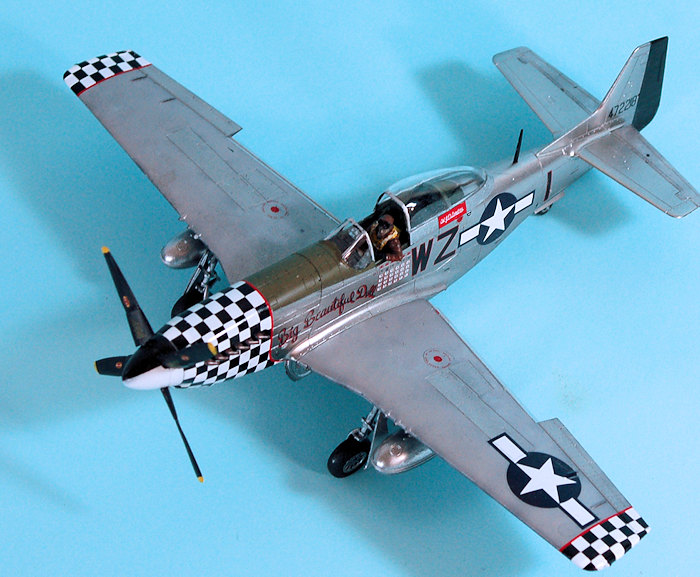 Having not
built a Tamiya P-51D in around four years, I decided I wanted to do this kit
OOB, other than modifying certain aspects in line with new research on the
Mustang, and to see just how it would look with Vallejo acrylic metal paint.
Having not
built a Tamiya P-51D in around four years, I decided I wanted to do this kit
OOB, other than modifying certain aspects in line with new research on the
Mustang, and to see just how it would look with Vallejo acrylic metal paint.
The main change in the model was to fill in the panel lines on the wing other than the gun bay panels, to create the puttied wing of the real thing. This was easily accomplished with Mr. Surfacer and several different sanding sticks, ending with super-fine to get the surface as smooth as possible.
Since I wasn’t going to use a resin cockpit to replace the rather basic offering in the kit, I decided to use the really good pilot figure this release includes to fill up the cockpit.
| COLORS & MARKINGS |
The Vallejo metal paints need a black primer. For a high gloss finish, gloss black is necessary. I have found that the Vallejo black primer does not create as smooth a finish as does thinned Tamiya X-1 Gloss Black. I thinned that 50-50 and misted it on to the model until I had a uniformly smooth high-gloss finish. I let that cure for a day.
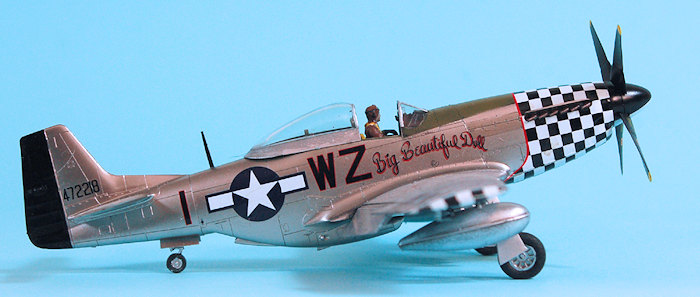 The wing was
painted with Vallejo “Aluminum” with a few drops of Tamiya X-2 Gloss White to
“grey out” the color. I let this set up for a day, then masked it with drafting
tape. I painted the olive drab anti-glare panel and masked it with Tamiya tape.
The wing was
painted with Vallejo “Aluminum” with a few drops of Tamiya X-2 Gloss White to
“grey out” the color. I let this set up for a day, then masked it with drafting
tape. I painted the olive drab anti-glare panel and masked it with Tamiya tape.
The rest of the model was painted with a base coat of Vallejo “Aluminum” straight from the bottle. Various areas were masked off with drafting tape and painted with “White Aluminum,” “Duraluminum,” and “Satin Aluminum.” The paint held very well with no pull-up, but then drafting tape is very low-tack and perfect for use on such a painted surface.
The kit decals were used to do Landers’ P-51D as it was seen at the beginning of May 1945, just after the group ceased combat operations. The decals are a bit thick but went down with absolutely no problems with a coat of Solvaset.
I placed the pilot figure in the cockpit with his arm on the cockpit sill. The landing gear was attached and the canopy attached in the open position.
| CONCLUSIONS |
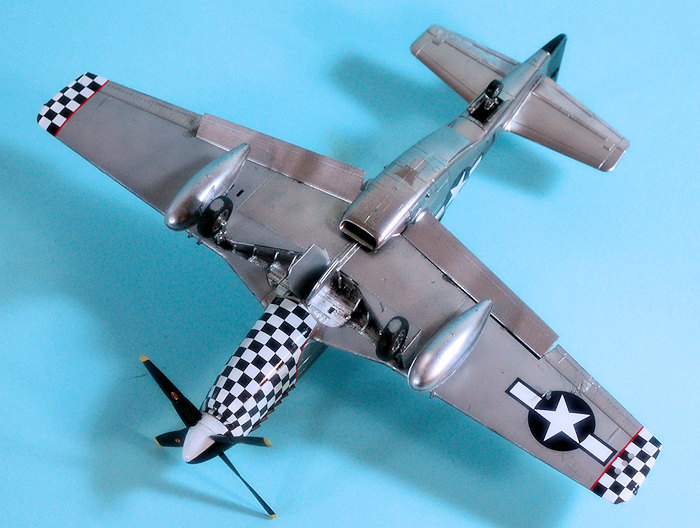 This
particular limited release includes decals for Landers’ airplane at two points
in its career, Clarence Bud Anderson’s “Old Crow” in camouflage and NMF, and
Chuck Yeager’s “Glamorous Glennis.” It’s well worth picking up if you run across
it. Vallejo metallic paints give a result that looks as good as Alclad, without
the stench. Properly applied, they are good-looking, and durable. Kit and paints
highly recommended.
This
particular limited release includes decals for Landers’ airplane at two points
in its career, Clarence Bud Anderson’s “Old Crow” in camouflage and NMF, and
Chuck Yeager’s “Glamorous Glennis.” It’s well worth picking up if you run across
it. Vallejo metallic paints give a result that looks as good as Alclad, without
the stench. Properly applied, they are good-looking, and durable. Kit and paints
highly recommended.
2 August 2016
Copyright ModelingMadness.com
Thanks to my wallet for the kit and paints.
If you would like your product reviewed fairly and fairly quickly, please contact the editor or see other details in the Note to Contributors.